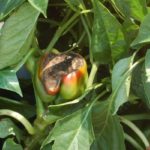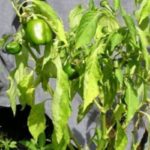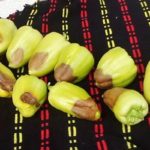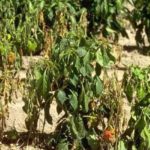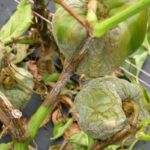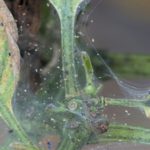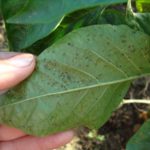Bulgarian pepper is very popular among gardeners of Belarus, Ukraine and Russia, whose land plots are located in the southern regions. This is due to the fact that cultivation of tasty and healthy fruits in more severe climatic conditions without using a greenhouse is extremely rarely a success.. In order to achieve the desired result, you must clearly follow the rules relating to planting seedlings in the ground and care for it.
Table of contents
Is it possible to grow sweet peppers in the open field?
Cultivation of Bulgarian pepper in the open field without special difficulties is possible only in the southern regions of Ukraine and Russia. Such a culture is considered to be thermophilic and may die when the temperature drops and unexpected frosts, too heavy rainfall can affect plant development.
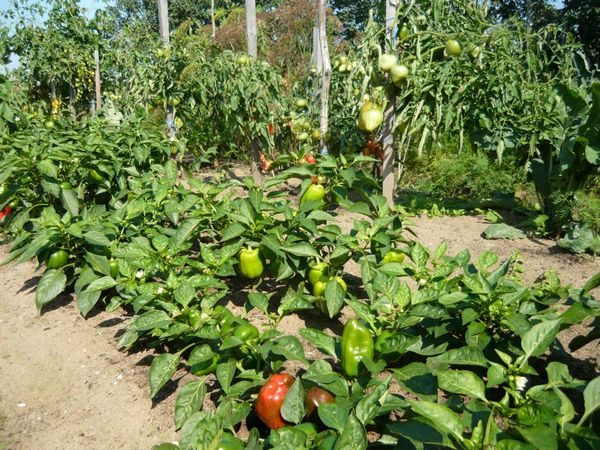
In order to grow peppers in the open field in the middle lane, Belarus and in the north of Russia should be planted in advance seeds for seedlings. In open ground planted at the age of 3 months that is, sowing seeds should be carried out in January-February.
The most popular varieties of bell pepper for cultivation in the open field
Bogatyr
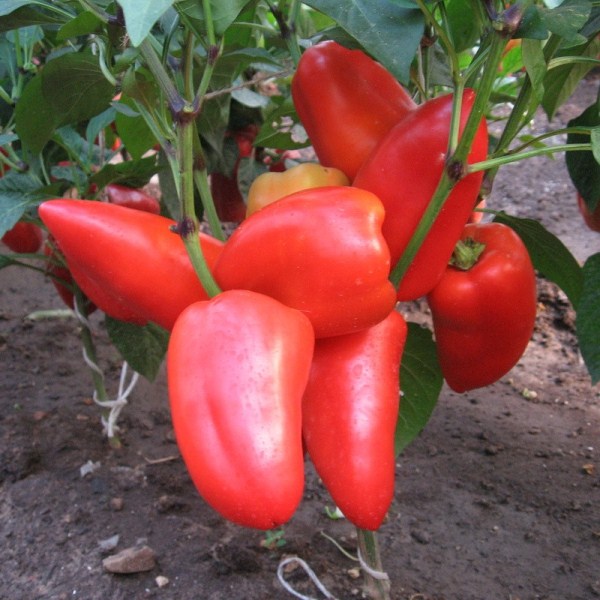
Maturation does not exceed 120 days. The bush is sprawling, up to 60 centimeters high. Fruits are large, weighing 150-180 grams are originally painted green, which gradually flows into red. The wall thickness is 5.5 millimeters. From 1 square meter receive up to 7.5 kilograms of crop varietiesBogatyr.
Swallow
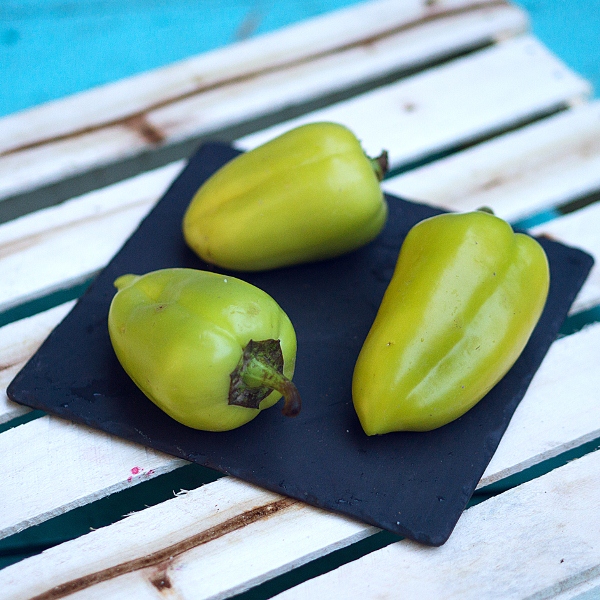
Harvesting can be carried out after 130 days. The height of the bush is on average 60 centimeters. Fruits are smooth, shaped like a cone, painted in bright red. Fruit weight Swallow varies from 70 to 80 grams, the wall thickness is 5 millimeters.
Merchant
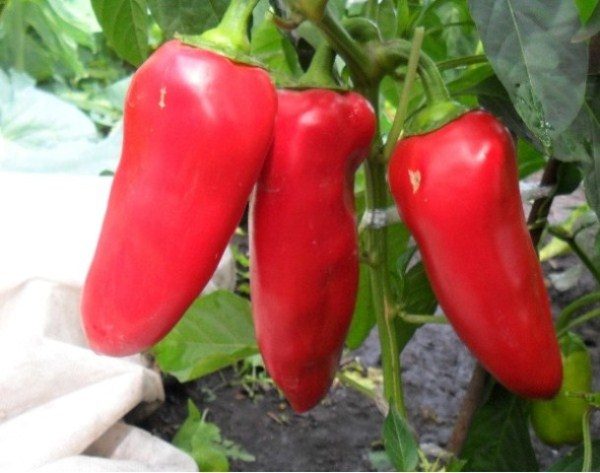
Early ripe variety, the first fruits of which appear in 100-110 days. Red, pyramidal peppers grow on bushes, up to 1 meter Fruits weighing 110-130 grams have a rich taste and aroma.
Belozerka
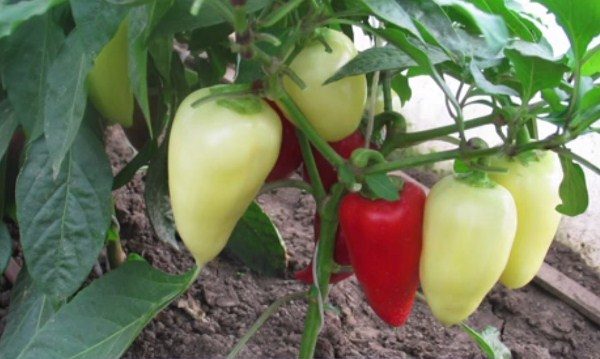
Belozerka enjoys special popularity. The ripening period is 112 days, the height of the bushes does not exceed 70 centimeters. Fruits are cone-shaped, can be painted in cream, yellow, orange or red shades. The wall thickness of pepper is 7.5 millimeters, and the average weight is 130 grams. The fruits ripen in unison, from 1 square meter to collect up to 8.5 kilograms of the crop.
Orange Miracle
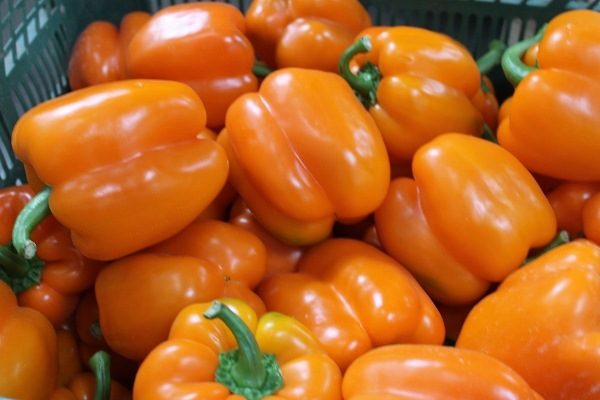
This variety is suitable for cultivation in the southern regions and ripens in 110 days. The bush is resistant to diseases, its height may exceed 1 meter. Fruits are cuboid, bright orange in color. The wall thickness can reach 10 millimeters, and the weight of one pepper is 250 grams. With 1 square meter you can collect up to 14 kilograms of fruit.
Landing rules
Planting peppers seedlings in open ground is considered a very demanding job, if not done correctly, you can completely destroy the plants.
Selection of seedlings
The initial stage that needs to be passed before planting is the selection of seedlings, the state of which will determine the quality of the future crop. Planting material can be grown independently, but it is worth remembering that such work should begin in the winter, otherwise the seedlings will not have time to grow to the desired size and the peppers will not ripen before the onset of cold weather.
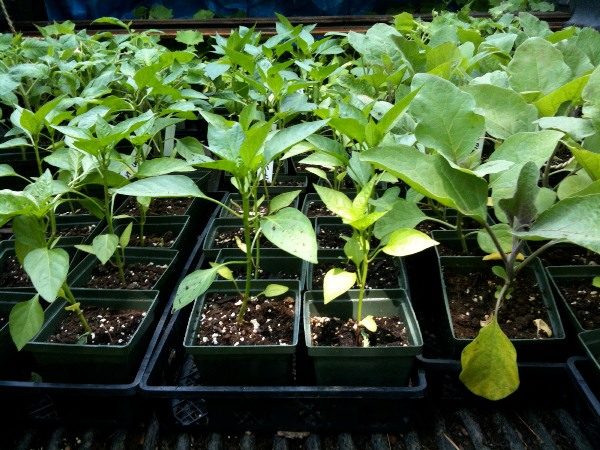
Buying seedlings in a specialty store is a great option for those who do not have time to care for and desire to tinker with seeds, but at the same time it is necessary to take into account factors indicating the condition of the seedlings:
- The leaves should be well developed, have a rich green color and smooth surface without stains and plaque;
- Bushes must be strong, plump and elongated up, drooping plants are unlikely to come alive when planted in the ground;
- If the leaves are too many, they are too lush and tall, then most likely the plants were overfed with growth stimulants and nitrogen fertilizers. In this case, they will badly bloom and bear fruit.
Soil preparation
What kind of soil is suitable and where to choose a place for growing sweet pepper? Bulgarian pepper prefers a light and slightly acidic soil, located on a sunny plot. Preparation of the soil for planting pepper should begin exactly one year:
- in the spring under the digging make organic fertilizer (5 kilograms per 1 square meter), which include rotten manure, humus or compost. At the same time, other crops can be grown on the soil, but not eggplants, tomatoes, and potatoes;
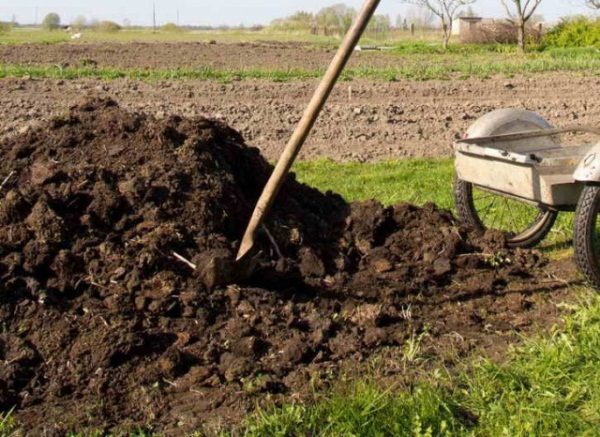
- autumn after harvest on 1 square meter of soil contribute 50 gram of phosphate and the same amount of potash fertilizers (superphosphate, urea);
- in early spring soil fertilized with ammonium nitrate (40 grams per 1 square meter);
- one week before landing the soil is disinfected.You can use one of the folk remedies - watering with copper sulfate or a solution of potassium permanganate.
The beds are formed in the form of grooves located at a distance of 70-80 centimeters from each other. At the same time, set the pegs, which will serve as a support for the bushes.
Planting in open ground
It is necessary to plant such a culture at the end of April and beginning of May, the specific dates will depend on the air temperature, which should not be less than 20-25 degrees.
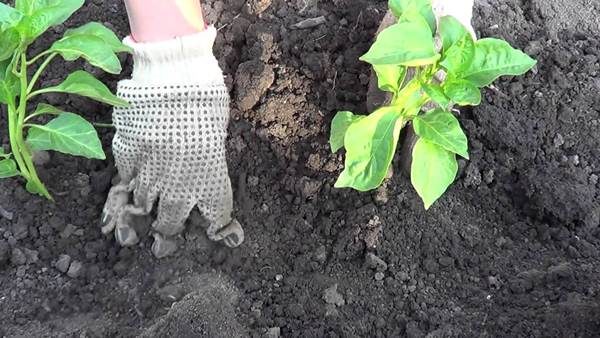
Sweet pepper is planted in shallow wells, located at a distance of 40-50 centimeters from each other. When performing work, you should adhere to the following rules:
- At the bottom of each hole spread on a tablespoon of complex mineral fertilizerwhich is mixed with the earth;
- Saplings pass over in the hole with earth lump;
- The wells are half filled then pour and fill the ground to the end;
- Root neck it must be on the same level with the ground;
- Experienced gardeners recommend apply mulching planting with peat.
Care for pepper in open field
Proper cultivation of pepper is the timely care and execution of all the necessary work, which include watering, weed removal, loosening, the formation of bushes and feeding.
Weed grass takes a large amount of nutrients from the soil, therefore, it is very important to remove it in time. Also, to improve the oxygen supply of the root system, the soil is regularly loosened to a depth of 2-3 centimeters. In order to keep the result of the work done as long as possible, the plants mulch with peat, grass or straw.
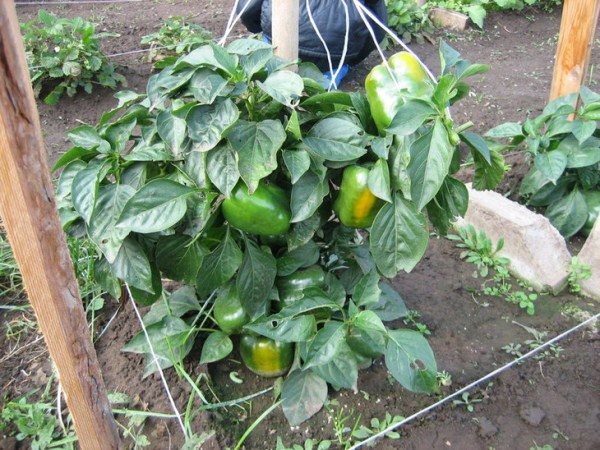
The formation of the bush is carried out according to the following rules:
- To increase yields the central flower, which appeared at the first fork, should be removed;
- Shrubs form into 2 or 3 stems, for this, it is necessary to remove lateral shoots (stepchildren) in time, such a procedure is called pasynkovaniem;
- On one plant leave no more than 25 pods, otherwise, they will become smaller or not be able to ripen at all;
- Peppers tall varieties should be tied to a support. This is necessary so that the plants do not break under the influence of a strong wind and do not overwhelm each other, hiding the sunlight.
Before flowering, sweet peppers are watered once a week, and during flowering and fruiting twice a week. In hot and sultry days, the amount of watering can be increased. For such purposes I use only soft and warm water. Water the peppers from the watering can, hoses or using a drip irrigation system.
How to feed
The plant in open ground is fed every two weeks, using phosphorus-potassium fertilizers. Also 2 times per season should make a solution of bird droppings, prepared in a ratio of 1 to 10.

The lack of a trace element can be seen as a plant:
- twisted leaves with dry framing speak of a lack of potassium;
- dull leaves with a gray bloom, which at the same time become much smaller, indicate a lack of nitrogen;
- if a plant drops ovaries and flowers, This means that the nitrogen in the soil is too much;
- purple the underside of the plate indicates a lack of phosphorus;
- marble color is a sign of magnesium deficiency.
Reproduction and picking
Propagation of Bulgarian pepper is carried out with the help of seed germination. First you need to prepare planting material. To do this, perform the following steps:
- seeds are released into the water with a temperature of 50 degrees for 5-6 hours;
- the next stage is their wrapped in a damp cloth and cleaned in a room with a temperature of 20-22 degrees for 2-3 days.
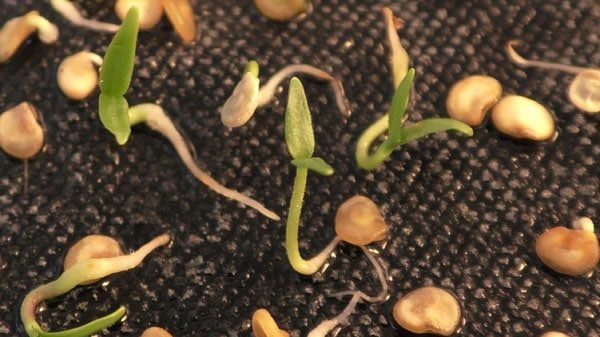
The substrate for peppers is prepared in the following proportions:
- 2 pieces of turf or garden humus;
- 1 part of sand;
- 1 part garden land;
- 0.5 parts ash.
Landing is carried out in wooden boxes and peat pots, deepening the seeds by 1.5-2 centimeters. After that, they are watered, covered with glass or film and cleaned into a room with a temperature of 21-22 degrees.
Water the seedlings moderately, not allowing drying and over-wetting of the soil. In this case, you should use only warm water. The plant loves light, its light day should last from 7 in the morning and until 9 in the evening, therefore in some situations it is necessary to use artificial lighting. It is also very important to spray plantings in a timely manner.
As soon as the first sprouts daytime indoor temperature must be at least 26-28 degrees and night should be equal to 10-15 degrees.
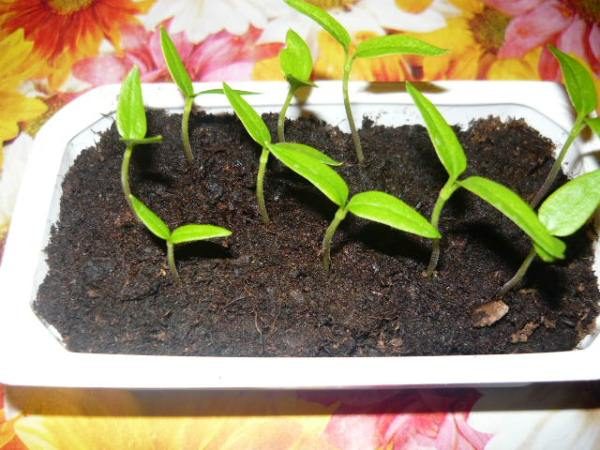
With the advent of the first pair of leaves, saplings dive into peat pots (if grown in a box) measuring 8 by 8 centimeters. Deepen plants with cotyledon leaves.
Seedlings should be fed twice: with the advent of the first and second pair of leaves. For such purposes, use complex fertilizers for seedlings.
The main mistakes in the cultivation of sweet pepper
- Planting seedlings too early in open ground may cause developmental delays and, accordingly, crop loss or plant death;
- If the plants start to stretch, and the ovaries form less and less, then most likely the pepper lacks sunlight. In such a case, it is necessary to thin the planting, removing the incorrectly growing and damaged leaves. Also, such a problem may arise due to non-compliance with the planting scheme of seedlings;
- Bell peppers have a very fragile root system, therefore, you need to be extremely careful during transplantation or loosening of plants;
- Pepper is considered a capricious culture regarding irrigation. Moisten the soil should be often and using a small amount of water. Drying or over-wetting of the soil can cause abscission of the ovaries and flowers;
- For a rich harvestbe sure to feed taking into account all the requirements of the plant.
Diseases and pests
Bulgarian pepper often suffers from the appearance of various diseases and pests.And in the first case, the treatment of plants does not bring any results, and the damaged bushes should be immediately removed and burned. Healthy plants are then treated with suitable fungicides in accordance with the instructions.
Gray rot, vertex rot, black pedal, late blight, fusarium, verticillis, etc. are most common in the culture under consideration.
- Gray rot
- Blackleg
- Fusarium wilt
- Vertex Rot
- Verticillosis
- Late blight
Of all the insects on the Bulgarian pepper settle:
- wireworm, getting rid of which is mono with the help of insecticides;
- spider mites well derived using infusion prepared from 10 liters of water, a tablespoon of liquid soap, a cup of chopped onion and 5-7 glasses of chopped dandelion leaves;
- get rid of aphids You can use the infusion of tobacco dust or ash. The insecticide Karbofos also helps.
- Spider mites
- Wireworm
- Aphid
Preventive methods will consist in carrying out all agrotechnical procedures in a timely manner and treating plants several times per season with Brodsky liquid or other similar preparations.
Harvesting
Harvesting peppers is carried out simultaneously with tomatoes and eggplants, usually, this period begins in early or mid-August. Ripe fruits are removed selectively once a week before the onset of frost. In order to keep the crop better, peppercorns are cut from the bush together with the stem.
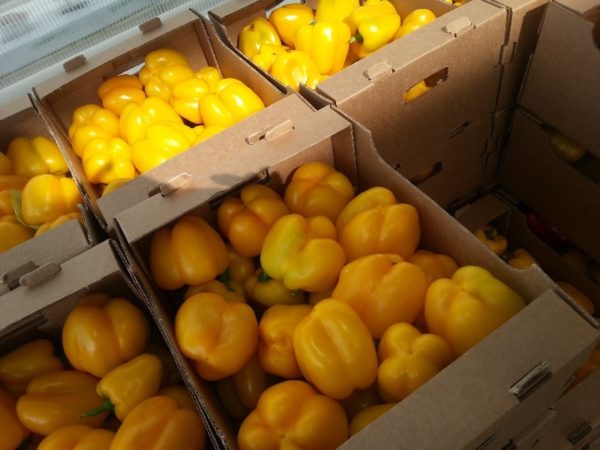
There are 2 degrees of ripeness of Bulgarian pepper:
- Technical ripeness - fruits are colored green and can be stored for up to 2 months;
- Biological ripeness - Peppers are colored yellow, orange, red or purple. The collected fruits should be consumed immediately or used for preservation, etc.
Between technical and biological ripeness is 20-30 days. The specific period will depend on the air temperature and lighting.
Bulgarian pepper is a rather capricious crop, and growing it at home in the open field is more suitable for experienced gardeners. Pepper needs favorable weather conditions and requires compliance with all rules relating to agricultural technology.

